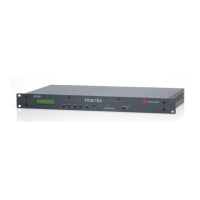T01FLASH
Execute hook flash.
If the phone is on-hook, no action is performed, and the response will
be
T01FLASH
If the phone is off-hook, the response will be
T01FLASH
T01PHONE0
T01PHONE1
The PHONE status messagges occur when the phone goes on-hook
and back off-hook.
8.25. FLOW -- Set Flow Control Mode for RS-232 Port
This command sets the flow control mode for the rear panel RS-232 port. The valid settings are:
Command Value Description
0 No flow control.
1 Hardware flow control.
2 Auto-detect hardware flow control or no flow control.
We recommend using hardware flow control whenever possible, especially when using higher baud
rates.
This command is saved to global non-volatile memory and is not part of a preset. Its value is saved
each time it is changed. It will retain its value after power-down. Since this command writes to non-
volatile memory, there will be a delay before an acknowledgment is returned.
Example Description Status Message
T01FLOW1
Set rear panel RS-232 port to use hardware
flow control.
T01FLOW1
T01FLOW?
Query flow control setting of rear panel RS-232
port.
T01FLOWx, where x is 0, 1, or 2
depending on the current flow control
setting.
8.26. FPLOCK -- Lock/Unlock Front Panel
This command controls the front panel lock feature. When FPLOCK is enabled, the user may not make
any changes to the system via the front panel. The system settings will still be viewable on the LCD,
but the user will get an error message if he tries to change them. When FPLOCK is disabled, the user
has full access to the system settings via the front panel.
Usage of this command is similar to other boolean commands (see
Section 6.1) except that when
disabling this feature, the password must be supplied for the command to work. If an incorrect
password is supplied, 'ERROR#005' will be generated. The examples below illustrate the correct usage.

